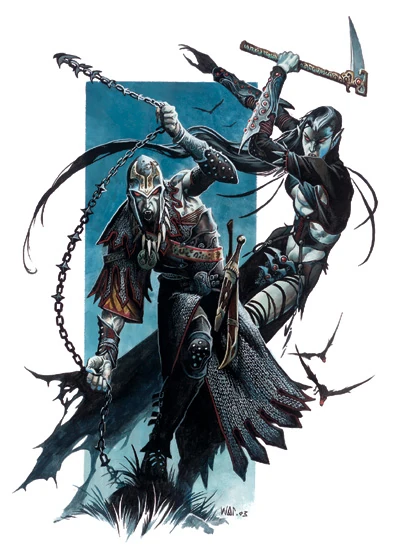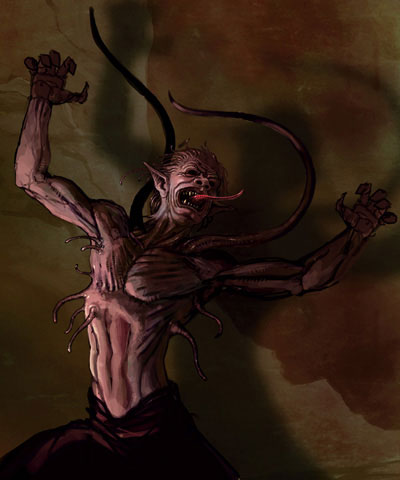From the journal of Diva’un Mur'ss, last of House Zaughym, Bale of Nightfall, Drinker of the Blood of Erebus the Thrice Unforgiven, Bringer of Darkness / Zarantyr 25th, 999 YK
The lack of leadership this "Winter Coalition" suffers has suited me well. I cannot yet envisage a future where I could unquestioningly accept an order from any of them. Now, however, with a battle before us that, at best, will leave us fewer in number, I see the disadvantage of not speaking in one voice. While a good argument can have all of the beauty of a well-planned assassination, this felt more like a brawl. Many of them have depleted their reserves beyond their ability to contribute to the battle to come.
 |
| Durag: "I am the night." |
While this democracy lumbered, Aleae asked Opal to invisibly scout the entrance through which the group had entered Glyphstone. After cheerfully completing her task, she reported back, in her sing-song voice, that the way out was now blocked by a wall of thorns and that "nasty, smelly, nasty, bat-things hung from the ceiling. Nasty ones."
 I have no idea how Aleae tolerates its cloying sweetness. Yet she comes from a plane where there are many more such frivolous beasts.
I have no idea how Aleae tolerates its cloying sweetness. Yet she comes from a plane where there are many more such frivolous beasts.In the end, Cypher was unwilling to risk not sending word out to the Brelish crown. This was not surprising. The odd warforged is one of three Last War veterans in this party; Clarion once served in the Aundairian army, and Wynn acts as though she is still part of Karrnath's military. I know only the fundamental politics and history of this land, though, having studied far more important things during my years. The "last war" will not be the last.
Clarion, with his preternaturally perfect script, penned a short letter on behalf of Cypher that the iron defender named Rungo would attempt to safely carry out of the Glyphstone Keep. The chances were not good, but then the loss of a homonculus was no true loss. The message was:
Wir, 25th of Zarantyr, 999 YK —
Urgent Message - Post-At-Once
To: Three, the King's Protector
From: Cypher, First Sergeant, Brelish Engineers Brigade, Retired
We have reconnoitered and made contact with the enemy within Glyphstone Keep and discovered a plot of grave consequence against Breland and Khorvaire. Imminently, Governor Trazzen intends to unleash a vile substance upon Sharn that will have devastating results. Suggest beginning immediate evacuations of the city and remove the King and his family far from Sharn and Wroat. The substance, which has been named the Mire of True Hunger, may have already been unleashed once upon another area of Breland, and there are future plans to set it upon Aundair and Wroat as well. We intend to defeat the Governor's plans but request immediate military assistance to cleanse Glyphstone in case we are unsuccessful in our mission.
 Included here are maps of an entrance to the Keep and its initial underground floor plan.
Included here are maps of an entrance to the Keep and its initial underground floor plan.As proof of the providence of this message, the iron defender Rungo is carrying something that the elves of House Phiarlan created just for you when we met at that dinner in Galethspyre.
For King and Country,
Cypher
Rungo rushed to the barrier of briars. Cypher communicated to us the disjointed thoughts of his homonculus as it worked its way passed the unnatural thorns and suffered an attack on the other side. With that, Cypher suddenly passed out, ending the ongoing debate and his narration of Rungo's progress. Some hurried repair restored him to consciousness and we learned that Rungo was now running and being chased. The attack on Rungo had injured Cypher, but Rungo had survived. Strictly speaking, this was because the warforged and his homonculus had imbibed something he'd called the Philter of Sacrifice, one of many items from the cabinet of curiosities he wears on his back. I was surprised to discover that warforged could even ingest potions.
With one message to the outside world dispatched, rest and preparation began for those who were not already asleep or in a trance-like state. I finished a circle of protection to ensure we finished our rest uninterrupted and began to meditate.
Aleae communed with Opal, slowly repeating our plight in the hope that the fey creature would bring us aid once its indenture had ended and it returned to its plane. Unfortunately the creature seemed not to comprehend the complex nature of the evil at hand nor could it fit the implications of the Rumdhal Cauldron into its very small mind. It chirped hope that Aleae would call on her again with the Wand of Wonder and it evaporated in a sweet-smelling cloud.
Some nine or ten hours after rescuing Irakas we assured her of our intent to return shortly and left her with her giant metal guardian while we made another attempt to alert the outside world to the perversities that were growing in power in Glyphstone Keep. I was not given the details of this second attempt, but it once again involved Cypher and some warforged device he carried.
 At this point, Clarion enacted a spell I did not realize he possessed and conjured a steed from the air itself. His variety of magic is certainly new to me, so I observed with interest. The horse that appeared was a mare, as large as the largest warhorse I'd ever seen—certainly large enough to bear the warforged's unforgiving weight. Her color was blue-green, somewhat like a magebred beast, but the hues were veined like a rough-cut gemstone. Clarion called her Amatrix, and I had the distinct impression that he did not give her this name but it was one that came with her.
At this point, Clarion enacted a spell I did not realize he possessed and conjured a steed from the air itself. His variety of magic is certainly new to me, so I observed with interest. The horse that appeared was a mare, as large as the largest warhorse I'd ever seen—certainly large enough to bear the warforged's unforgiving weight. Her color was blue-green, somewhat like a magebred beast, but the hues were veined like a rough-cut gemstone. Clarion called her Amatrix, and I had the distinct impression that he did not give her this name but it was one that came with her.I know of the Abyssal realms where Durag originated from. Whence comes this steed?
As I understood it, the final messenger—a small metal sphere that fit in some cavity in warforged's chest cavity—possessed the ability to convey itself in flight to another, designated warforged. Cypher spoke of Three, a warforged in the Brelish royal court who is close in counsel to the king. Although the final messenger could not transmit a lengthy message, a short one sufficed, along with some imagery associated with the warforged ejecting it. As Clarion suggested, the wording for this messenger was such:
Attacking Trazzen, Rumdhal Cauldron sending Mire of True Hunger to Unknown, Sharn, Aundair, Wroat, outcome uncertain. Prepare for impact. Send reinforcements. Angel Talor must prevail.
We made directly for the thorn-walled entrance Opal had described to us and, expecting as much, were not disappointed when two dire bats screeched, dropped down from dark perches, and flew towards us. Clarion, atop his new steed, charged them. I have witnessed many battles in subterranean passages, but this one was particularly striking in its irregularity: a small golem charging down a stone corridor on an aquamarine horse
The thunder of his mount's hooves in the enclosed corridor presaged the mighty impact as it reared up and struck one of the bats from the very air. There was a crunch as it stomped the skull of the fallen creature and Clarion struck the second bat with his steel-shod quarterstaff, injuring it. A third bat entered the fray and Magnus let loose two arrows from a newly-acquired bow. Arrows in name only as the shafts burned like bolts of flame that unerringly struck a bat. The bow seemed to vibrate with the violence, as if something wanted to escape.
Izzeth and I cast damaging spells at range and Cypher, who intended to release his final messenger once on the other side, began to immediately work his way through the thick tangle of thorns. The bats were no great obstacle and I was able to dispatch one of them, drawing on its life to bolster my own.
My hunger quieted for another day as its wasted life was put to good use.
We could hear a struggle past the magically aggressive vegetation and Cypher burst back through, trailing vines and thorns.

Cypher called out a warning that more enemies may be coming. His words suggested a plant-like woman and he also cited the presence of a large beetled.
A moment later, a dryad emerged effortlessly from the brown and green wall, looked us over, and began to scream an alarm. I have never looked upon a dryad before—as an afterthought, I thought quite lovely. But also probably a threat. It was strange to see such a gentle creature in the service of our enemies, but I remembered that Frost, an elvish druid, was one of Trazzen's cohorts. She herself is no gentle elfmaid, but a violent spellcaster with enigmatic powers of her own. Where most druids treat nature with respect and call upon it only to protect it, Frost and the Children of Winter weaponize it.
Izzeth and I both attempted to quiet the tree spirit with placating words as we backed away. I was aware that we were the only ones who reacted thusly, but our reasons were obviously not mutual.
While the druid's connection to nature obviously motivated him, I would keep my reasons to myself.
Perhaps one of us would have gotten through to her, but Aleae was having none of it. A blast of ice arced from Aleae's palms striking the dryad, then Aleae ducked into cover. The dryad's reply was scream the words, "Look at me!" All of the men in our party where compelled to look at her.
Eyes locked on her, we felt a wave of compulsion—of desire, of reflection, but also of pain—yet none of us succumbed fully to her enchantment. My eyes stung from the magic, but nothing more. It will be a waste to end such a regal creature, but if it costs the lives of a thousand innocents, Katashka must be disappointed.















